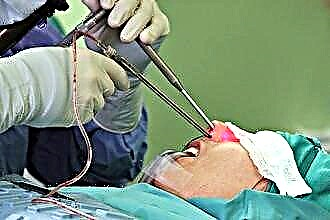Precancerous conditions
Particular attention is paid to the study of the larynx, since this localization of the malignant process accounts for at least half of all cases of oncopathology of the respiratory system. The course of laryngeal cancer, its prognosis largely depends on which part of the organ is affected by the malignant process. Anatomically, the following departments are distinguished in the larynx:
- supra-fold, which is located above the vocal folds;
- directly, the vocal cords;
- lining.
The most dangerous localization of the process is the upper section, since it is characterized by a well-developed lymphatic network, loose tissue, which creates a risk of rapid spread of metastases.
An important part of prevention is the detection and timely correction of diseases that, under certain conditions, can transform into throat cancer. Such precancerous conditions are:
- papillomas;
- leukoplakia;
- fibroma;
- scar tissue.
A particular danger is the presence of papilloma, a benign tumor, which is most often prone to mutation into a malignant neoplasm. Detection of a tumor allows a preventive examination, including laryngoscopy.
Timely detection of precancerous conditions and removal of benign tumors will prevent serious consequences.
Survey techniques
You can diagnose any pathology by studying a number of factors:
- patient complaints;

- a history of a specific disease;
- anamnesis of life;
- the results of an objective examination of the patient, including instrumental methods, hardware techniques and laboratory diagnostics.
Clarification of the diagnosis begins with an examination of the patient's complaints. In the case of a pathology of the throat, the following complaints come to the fore:
- choking;
- feeling of discomfort when swallowing;
- changing the timbre of the voice;
- dry cough;
- difficulty breathing.
Depending on the localization of the process, certain complaints may prevail. With the defeat of the laryngeal laryngeal apparatus, voice changes are most characteristic. He becomes hoarse, hoarse, a feeling of fatigue from talking is noted. As the process develops, the voice becomes silent.
For cancer of the subglottic region, a dry, irritating cough is most common.
When the tumor grows, difficulty breathing is added to these symptoms, up to attacks of suffocation.
The greatest difficulty in early diagnosis of laryngeal cancer is the process localized in the upper section, supraglottic. This is due to the fact that the patient does not complain for a long time. Only as the tumor grows does it begin to disturb the change in the timbre of the voice, choking, difficulty and pain when swallowing, radiating to the ear.
In case of an untimely appeal to a specialist, ignoring the medical examinations of the patient, the following complaints may be disturbed due to the spread of the process and the growth of a malignant tumor:
- weakness;
- malaise;
- decreased appetite;
- weight loss;
- subfebrile condition;
- bad breath;
- hemoptysis;
- suffocation.
Objective research methods
 However, symptoms of throat lesions can also occur in other pathological conditions, such as laryngitis, laryngotracheitis, damage to the upper respiratory tract with specific pathogens. In addition, a change in the timbre of the voice is a characteristic feature of smokers and people who abuse alcohol. In this regard, the role of objective examination methods is significantly increasing. Diagnosis of laryngeal cancer includes the following tests:
However, symptoms of throat lesions can also occur in other pathological conditions, such as laryngitis, laryngotracheitis, damage to the upper respiratory tract with specific pathogens. In addition, a change in the timbre of the voice is a characteristic feature of smokers and people who abuse alcohol. In this regard, the role of objective examination methods is significantly increasing. Diagnosis of laryngeal cancer includes the following tests:
- examination by an otolaryngologist;
- laryngoscopy;
- biopsy;
- Ultrasound of the neck;
- computed tomography;
- magnetic resonance imaging;
- ECG;
- chest x-ray.
If lung metastases are suspected, bronchoscopy may be necessary.
The objective of an objective examination is not only to diagnose the tumor, but also to determine its primary localization, since the throat can be the site of cancer metastasis from other organs and systems.
Localization of the primary process is of great importance to determine the treatment tactics.
Instrumental examinations
After listening to the patient's complaints, the ENT doctor proceeds to conduct an indirect laryngoscopy. It is carried out directly in the office. No special training is required for this. To exclude the development of the gag reflex, it is advisable that food and water are not taken immediately before the procedure.
The procedure consists in the fact that pressing the tongue with a spatula, the doctor uses a mirror to examine the oral cavity and pharynx. The disadvantage of this method is its low information content. It is possible to diagnose a tumor only in 30% of cases. Due to the fact that it is not possible to fully examine all parts of the larynx, the otolaryngologist is forced to prescribe more laborious studies.
Direct laryngoscopy is characterized by great diagnostic capabilities. A significant number of medical institutions are equipped with the appropriate equipment to conduct such a study. It consists in introducing a laryngoscope into the larynx with a flexible tube in order to study all of its departments.
The study is carried out under local anesthesia by spraying the drug into the throat cavity. In addition, since the examination apparatus is inserted through the nose, vasoconstrictor drops are first instilled into the patient, which reduce swelling and mucus production. A significant advantage of this technique is its information content, safety, the possibility of simultaneous removal of papilloma, as well as taking material for biopsy.
The identified changes can vary significantly in nature. Alertness should be caused by formations in the form of a tubercle or a tuberous surface, localized in various places of the larynx, thickening of the vocal cord, its bleeding. The altered mucous membrane in the form of an erosive area is also a cause for concern and further research.
After instrumental examination by means of indirect laryngoscopy, the ENT doctor proceeds to an objective examination of the patient. He is interested in the state of regional lymph nodes. By palpating the cervical, mandibular, jugular lymph nodes, the doctor receives information about possible metastases.
Enlarged dense formations fused with nearby tissues indicate the spread of the process and the transition of the disease to the third stage.
At the same time, soft painful lymphoid formations characterize the presence of an inflammatory process in the throat and oral cavity.
To clarify the nature of the defeat of the lymph nodes, ultrasound of the neck is used. Such a study allows one to assess their density, size and localization.Given the information content and safety of such a technique, it has become widespread to clarify the degree of damage in throat cancer. Many lymph nodes are inaccessible to palpation. At the same time, they are well visualized when examining them by the ultrasound method. Identified such echo-negative areas are subjected to further biopsy to clarify the presence of metastatic lesions in them.
The organs of the digestive tract, kidneys, and the brain are also subjected to ultrasound examination. Such studies are carried out to identify metastases to various organs. In addition, laryngeal cancer can develop secondary, by metastasis from the brain, breast, bone and cartilage tissue. Having identified malignant neoplasms, the specialist must decide on the localization of the primary focus.
Biopsy
A biopsy is the most informative study that can reliably clarify the diagnosis. It consists in the study under a microscope of the altered tissue area selected during direct laryngoscopy. The material necessary for diagnostics can also be obtained during other procedures, when a piece of tissue for research can be taken with a special needle.
The detection of atypical cells during microscopic examination allows one to draw a conclusion about the existing malignant process.
The same study clarifies the specific histological form of the cancer process, which is an important factor for further prognosis of the disease. The third stage of laryngeal cancer is characterized by the presence of metastases to regional lymph nodes. In this regard, the detection of such cells in enlarged lymphoid formations is not only a confirmation of the diagnosis, but also determines the stage of the process.
A biopsy is also used when a papilloma or other tumor-like formation is removed. It is not always possible to reliably clarify the diagnosis by visual examinations. In this regard, histological examination of distant education is a necessary and obligatory action.
Hardware techniques
Computed tomography and magnetic resonance imaging are the most modern hardware techniques used to examine the throat. The use of the latest technologies makes it possible to obtain a layer-by-layer image of formations, to study their localization, size, structure. Such studies help to clarify the stage of the disease, localization of metastases, which is important for the correct treatment.
 Chest X-ray allows detecting metastases to the lungs and lymph nodes of the mediastinum, and therefore, it is included in the mandatory set of examinations for suspected throat cancer. Diagnosis of the disease also includes mandatory electrocardiography. The study of the heart in this case is also mandatory, since many therapeutic measures may depend on the state of the cardiovascular system. Evaluating the work of the heart by means of an ECG is a reliable technique.
Chest X-ray allows detecting metastases to the lungs and lymph nodes of the mediastinum, and therefore, it is included in the mandatory set of examinations for suspected throat cancer. Diagnosis of the disease also includes mandatory electrocardiography. The study of the heart in this case is also mandatory, since many therapeutic measures may depend on the state of the cardiovascular system. Evaluating the work of the heart by means of an ECG is a reliable technique.
After an X-ray examination of the chest organs, bronchoscopy is recommended in some cases. The technique becomes relevant if the X-ray examination leaves the question of the presence of metastases in the lungs and mediastinum unresolved. In this case, a bronchoscope, with the help of a flexible catheter, is inserted into the bronchi, where the picture of the mucous membrane and the presence of neoplasms are studied.
Lab tests
Laboratory diagnostics includes general clinical examinations, which include a general analysis of blood, urine, blood sugar, RV, determination of blood group and rhesus. When the process spreads and metastases are detected, a biochemical blood test is also prescribed, which makes it possible to judge the metabolic processes occurring in the body, the functioning of the digestive tract, kidneys, and the endocrine system.
An increase in ESR and leukocytosis without signs of inflammation indicates a possible malignant process in the body.
The presence of a change in laboratory examinations in combination with the patient's complaints is an indispensable condition for contacting a doctor to clarify the diagnosis. Refining laryngeal cancer, which is often diagnosed based on additional examinations, can be a laborious process. However, early diagnosis is an important task that will prolong the patient's life.




